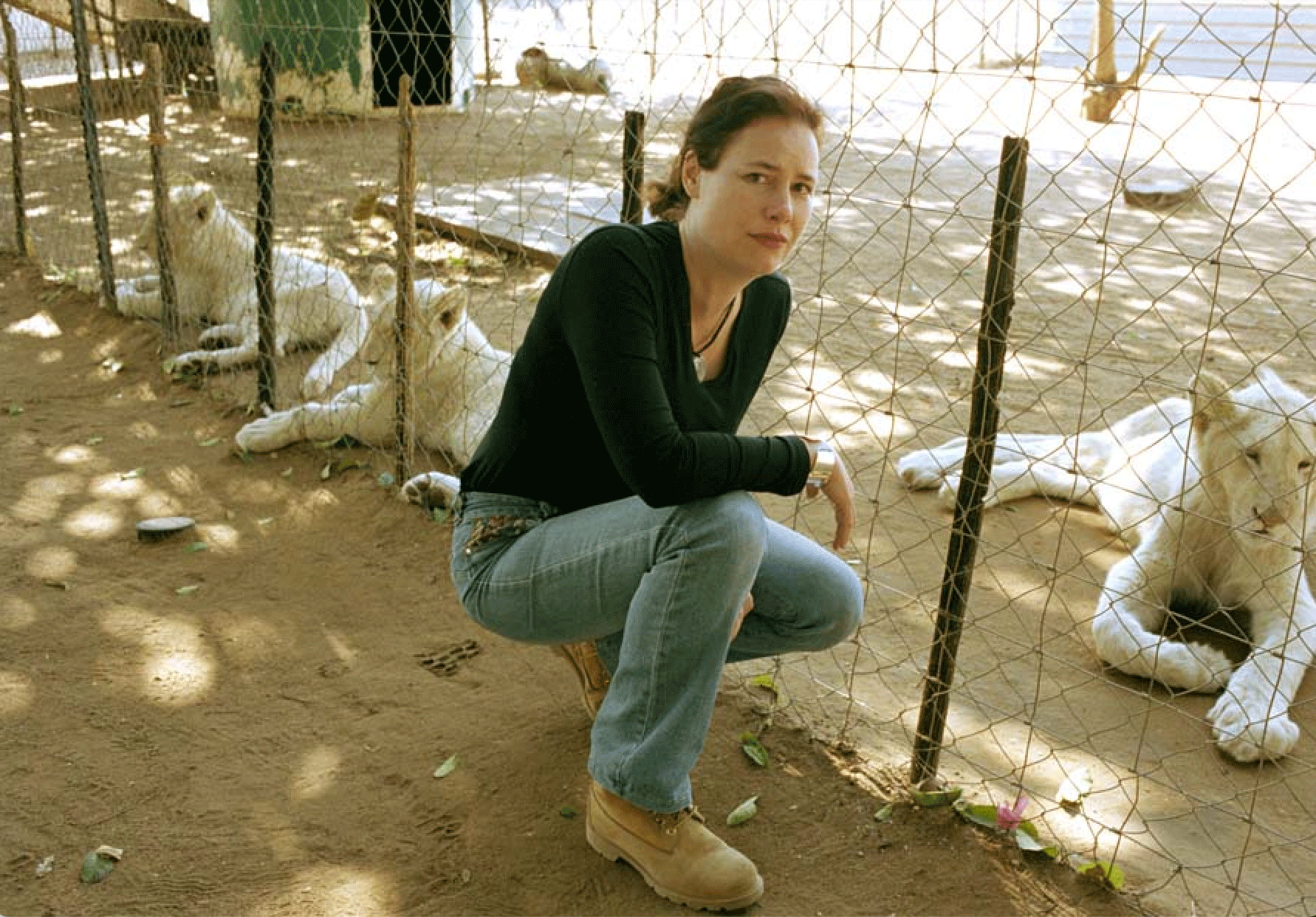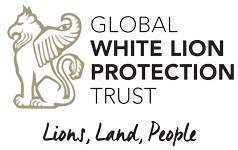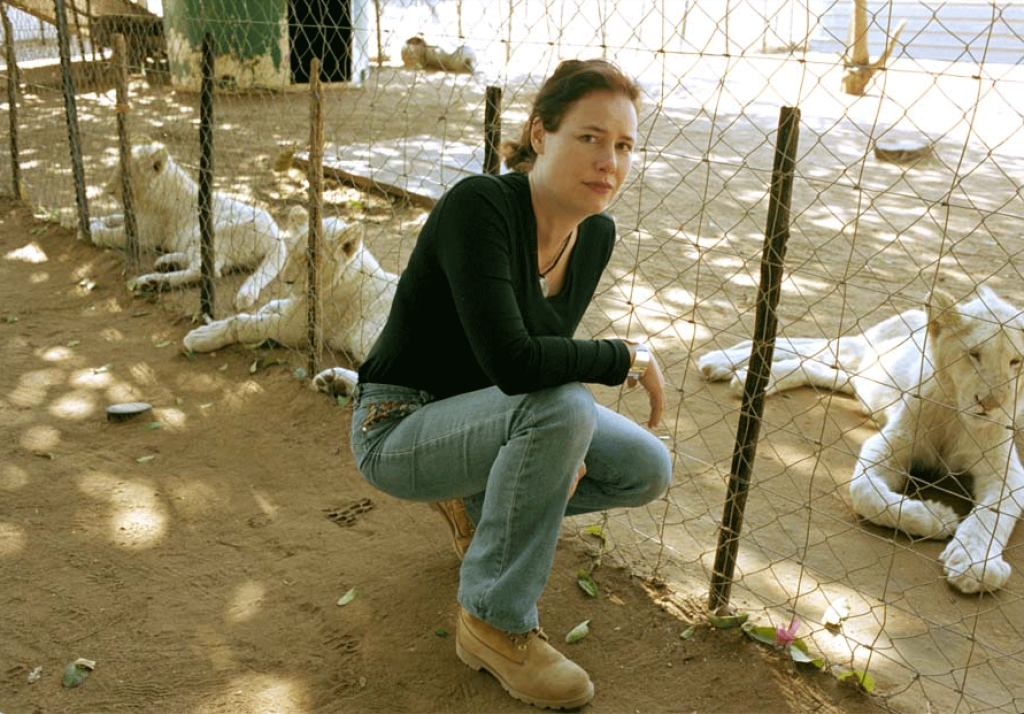
Finally – An Exit for the “Cuddle–to–Kill” Industry?
A Lamentable History
For decades, the so-called “canned” lion hunting industry has faced public scrutiny – first, through the shocking 1997 Cook Report expose, which coined the tragic name for commoditized lions “in a can”. The malpractice of breeding and killing lions in captivity started as dark deals done by international syndicates in the underbelly of society, stealing lions from the wild and holding them in tiny cages for mass production. After these undercover activities were exposed, the industry exploded into a grotesquely sanitised, multi-tiered money-making scheme that cons unsuspecting tourists in the name of conservation, who pay to cuddle baby cubs which will later be killed. Today, as many as 12000 lions are bred in over 300 camps across South Africa – waiting to be shot by wealthy hunters or slaughtered for the lion bone trade.
Finally, after decades of campaigning, presentations to parliament, and public outcry, the South African government declared in 2021 that this heinous industry would finally be shut down. In March 2024, Environment Minister Barbara Creecy’s Policy Position to close close lion facilities and end commercial exploitation of lions and ‘canned’ hunts was accepted by Cabinet. In April 2024, the Ministerial Task Team published a much-anticipated report, which outlines the first major step in the actual process: the voluntary exit options for existing captive breeders across the country.
“The easy slaughter of animals in fenced areas is called “canned hunting”, perhaps because it’s rather like shooting fish in a barrel. A fully-grown, captive-bred lion is taken from its pen to an enclosed area where it wanders listlessly for some hours before being shot dead by a man with a shotgun, handgun or even a crossbow, standing safely on the back of a truck. He pays anything from £5,000 to £25,000, and it is all completely legal.” Patrick Barkham, The Guardian, 03 June 2013.
In 2002, Linda Tucker founded the Global White Lion Protection Trust after nearly a decade of primary research into the conservation and cultural importance of White Lions. At the time, commercial trophy hunting and other forced removals of lions (into zoos, circuses, and captive breeding camps) from the Timbavati region had rendered White Lions extinct in the wilds of their endemic habitat. Since its inception, the Global White Lion Protection Trust has campaigned against the hunting of lions, whilst simultaneously adopting a pioneering conservation model that puts the interests of Nature first.
Linda Tucker has been campaigning against this heinous industrialising of lions since the 1990s, and famously rescued a White Lioness, who was born in one of these lion death camps neighbouring the town of Bethlehem in 2000. In 2005, Marah, whose mother had been forcibly removed from the wilds of her endemic ecosystem, was the first White Lion to be successfully reintroduced (with her cubs) to the wilderness lands of her origins. In the very heart of their original ecosystem, the White Lion Heartlands was purchased, protected, and responsibly managed by the Global White Lion Protection Trust over the decades, where today Marah’s lineage continues to thrive to the 4th generation in nearly 6000ha of pristine wilderness.
Linda Tucker detailed this “cuddle-to-kill” phenomena in her 2018 TEDx Talk.
In 2008, Linda first presented in South African Parliament calling for the White Lions to be declared a global heritage and protected by national law, and it was formally gazetted that the SA Government would take the responsibility of preserving this uniquely iconic species. Tragically, however, the reverse proved to be the case over the next 16 years, with these genetic rarities being cruelly exploited at the epicentre of this diabolical industry.
Ministerial Task Team Report: A Roadmap to Recovery?
For decades, Linda and her team have worked tirelessly to raise awareness about this burgeoning cuddle-to-kill industry whilst modelling a non-exploitative alternative in support of Nature – and as such, much of what is proposed in the Ministerial Task Team report is encouraging.
Above all else, the big win for lions is the now-legislated confirmation that all existing captive breeding facilities will need to be shut down.
The report also contains the following notable recommendations and proposals:
- Rapid implementation of a government-sanctioned acquisition and mass-incineration of all known lion bone stockpiles, and facilities that wish to take this offer must also comply with the principles of voluntary exit, namely sterilisation, as well as ensuring animal welfare and well-being.
- Well-being of animals should be defined and regulated, and the Minister must ensure enforcement of this standard across all facilities;
- Immediate moratorium on new captive lion facilities and reducing captive lion numbers by single sex separation or sterilisation;
- Moratorium on the import of all captive carnivores, so as to reserve the limited capacity in true sanctuaries for lions involved in the proposed exit strategies;
- Southern Africa should endeavour to reach a regional consensus on the closure of the captive lion industry, so that these practices will not switch to other African countries, such as Botswana, Zimbabwe, and Mozambique;
- The moratorium on the breeding of captive lions should include all carnivores.
The 250-page report must be commended for its extensive research and the flexibility of its proposals in tackling this deeply complex and grossly escalating internationalised industry. With this in mind, there exists several ethical and practical hurdles that remain seriously concerning.

Linda Tucker at a Canned Hunting operation on the borders of Timbavati in the 90s, lamenting the desperate condition of subadult White Lion cubs bred-to-be-killed, whose direct family members were stolen from the wild. (Photo: Tom Stoddard)
Whilst the report sets out a time-frame of 12-24 months for facilities to take up the voluntary exit options, it does not bind government to a deadline for ensuring the complete closure of the industry. We sincerely hope that an immovable deadline will be announced in due course, since at the current time, facilities resisting closure will continue to exploit lions indefinitely.
The successful shutting down of the industry – whether voluntary or compulsory – will require synchronisation of legislation to ensure consistency in descriptive definitions and references to animal welfare, among other inconsistencies. Additionally, considerable attention must be given to how these new policies will be enforced, particularly within a governmental system that is already struggling to meet its obligations. This task poses significant logistical hurdles that must be carefully navigated to ensure effective implementation.
The Way Ahead
To truly shift away from this grossly exploitative paradigm, based on consumptive and extractive-use agendas, requires a commitment to restore right-relationship with Nature, thereby placing the regeneration of our living Earth at the centre of all decisions affecting our mutual future.
Having finally taken the decision to shut down the heinous captive breeding industry, the South African government has since begun legislating a “Wildlife Economy Model,” based on what is being termed “authentic trophy hunting of iconic species”: Lion, Leopard, Elephant, and Rhino. If our true commitment is to restore right-relationship with Nature, the Global White Lion Protection Trust cannot endorse this newly defined exploitative strategy.
Having implemented a model for harmonious coexistence between Lions, Land and People in one of the last viable lion ranges on the planet over a period of 3 decades, our work has evidenced alternative solutions that advance new-paradigm conservation strategies for rural communities on the borders of wilderness areas that are fundamentally regenerative, non-invasive and non-exploitative of Nature.
Taking the “con” out of conservation
To truly “con-serve” we have to stop conning ourselves and others, and truly start serving Nature. Linda Tucker points out that the only way forward in these critical times, requires genuine sacred service: a commitment to honour, cherish and steward Nature as a precious living legacy for future generations, and thereby reinstate a loving and respectful interrelationship. This concept forms the basis of the pioneering LionHearted Leadership™ model, which focuses on the emergence of a new humanity, with a truly inspired LionHeart, and a commitment to sacred service of planetary life.
“Mother Nature and all her creatures are exquisitely sentient, and now more than ever we are called upon to live each day in respectful acknowledgement of that timeless truth.” Linda Tucker
Going forward, it behoves government to set aside areas of wilderness-for-wilderness sake, while shifting from an exploitative to a regenerative model, thereby reviving Indigenous and local community wellbeing, which in turn will support the dignity and wellbeing of iconic animals.
Unless the Wildlife Economy Model makes this critical shift – from exploitative to regenerative – South Africa’s new draft legislation risks perpetuating the sins of the old consumerist regime that has brought humanity to the brink.






